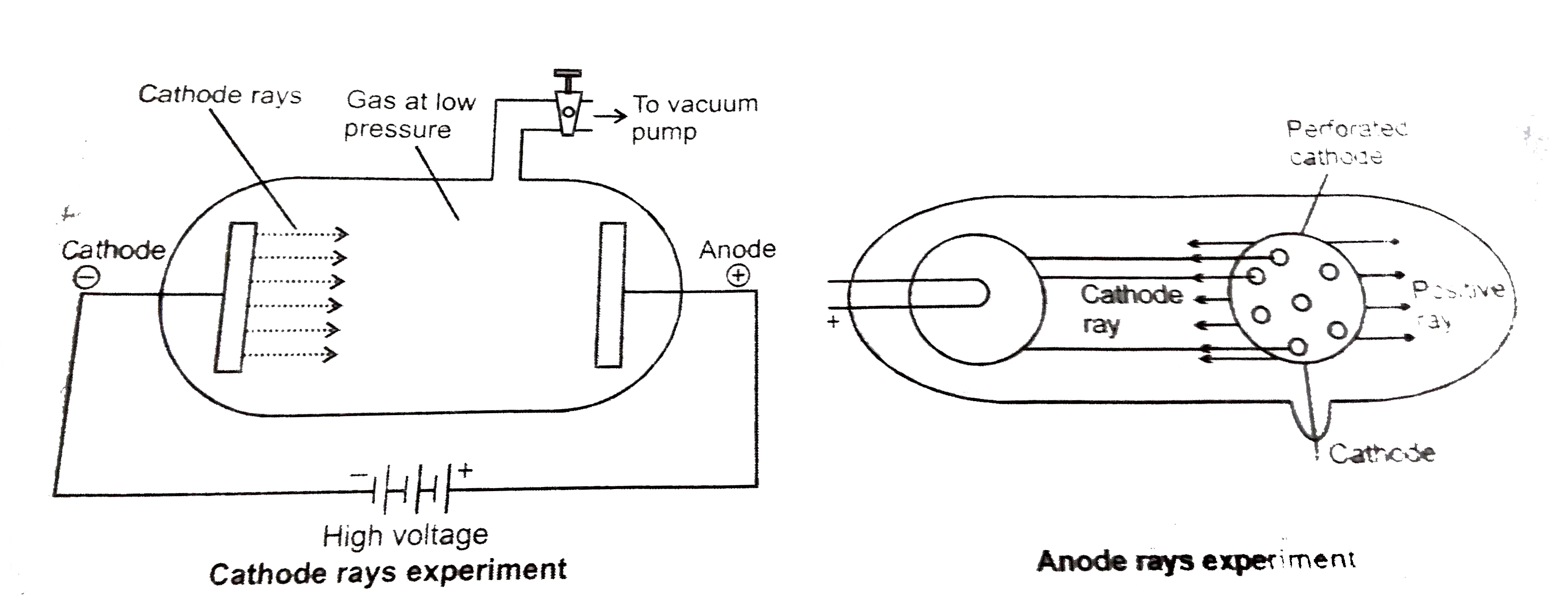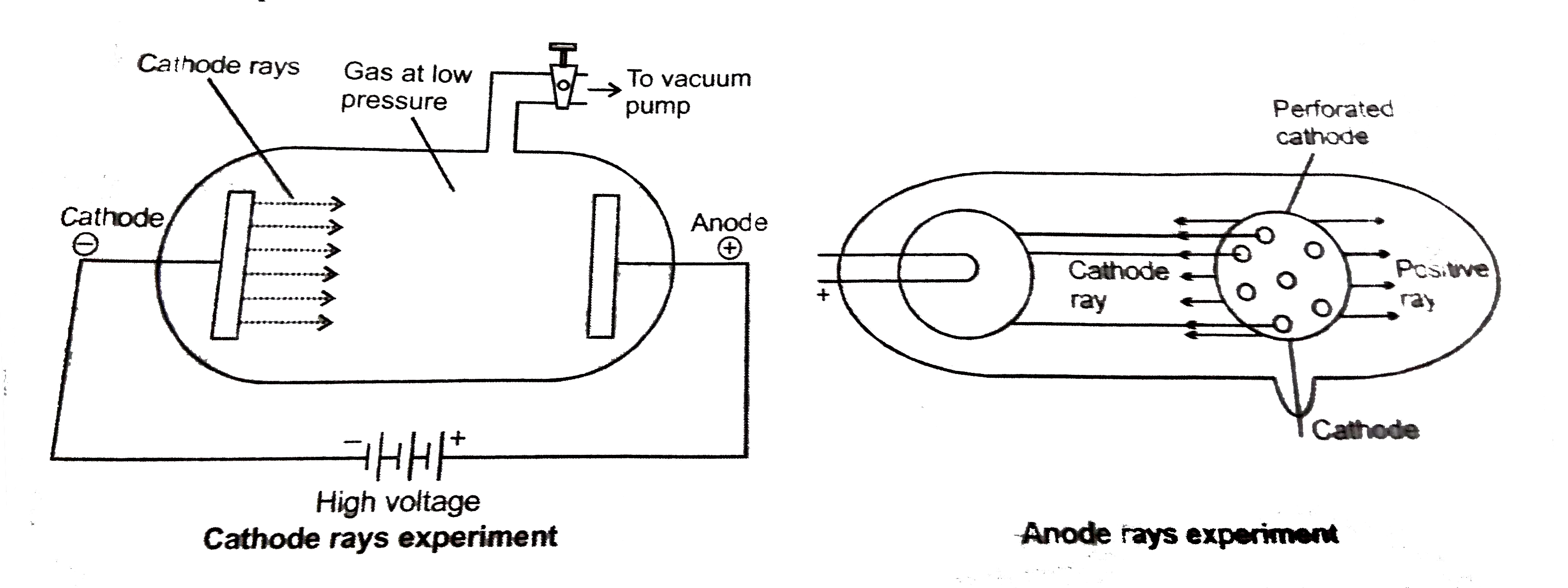How do cathode rays differ from anode rays?
To answer the question "How do cathode rays differ from anode rays?", we can break down the differences into several key points:
1. Definition of Cathode Rays:
- Cathode rays are streams of negatively charged particles, primarily electrons. They are produced in a vacuum tube when an electric current passes through a gas at low pressure.
Hint: Remember that cathode rays are associated with the cathode, which is the negative electrode.
2. Definition of Anode Rays:
- Anode rays, on the other hand, are streams of positively charged particles, typically protons or other positive ions. They are produced when electrons are removed from gas atoms near the anode, which is the positive electrode.
Hint: Anode rays originate from the anode, which is the positive electrode.
3. Charge of Particles:
- Cathode rays consist of negatively charged particles (electrons), while anode rays consist of positively charged particles (protons or positive ions).
Hint: Focus on the charge of the particles in each type of ray.
4. Direction of Movement:
- Cathode rays move towards the positive plate (anode) due to their negative charge, while anode rays move towards the negative plate (cathode) because they are positively charged.
Hint: Think about how opposite charges attract each other.
5. Charge-to-Mass Ratio (q/m):
- The charge-to-mass ratio for cathode rays (electrons) is constant for all gases, whereas the charge-to-mass ratio for anode rays varies depending on the type of gas used, as it can consist of different positive ions.
Hint: Consider how the nature of the particles affects their charge-to-mass ratio.
6. Composition:
- Cathode rays are made up of electrons, while anode rays are made up of ions or protons, depending on the gas from which they originate.
Hint: Remember that cathode rays are purely electrons, while anode rays can be a mix of positive ions.
Summary:
In summary, cathode rays differ from anode rays in terms of their charge, direction of movement, composition, and the consistency of their charge-to-mass ratio. Cathode rays consist of negatively charged electrons that move towards the positive plate, while anode rays consist of positively charged particles that move towards the negative plate. The charge-to-mass ratio for cathode rays is constant, while it varies for anode rays.
- Cathode rays are streams of negatively charged particles, primarily electrons. They are produced in a vacuum tube when an electric current passes through a gas at low pressure.
- Anode rays, on the other hand, are streams of positively charged particles, typically protons or other positive ions. They are produced when electrons are removed from gas atoms near the anode, which is the positive electrode.
- Cathode rays consist of negatively charged particles (electrons), while anode rays consist of positively charged particles (protons or positive ions).
- Cathode rays move towards the positive plate (anode) due to their negative charge, while anode rays move towards the negative plate (cathode) because they are positively charged.
- The charge-to-mass ratio for cathode rays (electrons) is constant for all gases, whereas the charge-to-mass ratio for anode rays varies depending on the type of gas used, as it can consist of different positive ions.
- Cathode rays are made up of electrons, while anode rays are made up of ions or protons, depending on the gas from which they originate.
In summary, cathode rays differ from anode rays in terms of their charge, direction of movement, composition, and the consistency of their charge-to-mass ratio. Cathode rays consist of negatively charged electrons that move towards the positive plate, while anode rays consist of positively charged particles that move towards the negative plate. The charge-to-mass ratio for cathode rays is constant, while it varies for anode rays.
Topper's Solved these Questions
- BOOK - ICSECHAPTER - ATOMIC STRUCTURE AND CHEMICAL BONDINGEXERCISE - EXERCISE 4(B)12videos
ATOMIC STRUCTURE AND CHEMICAL BONDING
- BOOK - ICSECHAPTER - ATOMIC STRUCTURE AND CHEMICAL BONDINGEXERCISE - EXERCISE 4(C)54videos
ATOMIC STRUCTURE AND CHEMICAL BONDING
- BOOK - ICSECHAPTER - ATMOSPHERIC POLLUTIONEXERCISE - EXERCISE 8(D)38videos
ATMOSPHERIC POLLUTION
- BOOK - ICSECHAPTER - CHEMICAL CHANGES AND REACTIONSEXERCISE - EXERCISE 2(C)30videos
CHEMICAL CHANGES AND REACTIONS
Similar Questions
Knowledge Check
- Question 1 - Select One
Astral rays arise from
AcentrioleBcytoplasmCchromatidDcentromere - Question 2 - Select One
Assertion : The characteristics of cathode rays do not depend upon the material of electrodes and the nature of the gas present in the cathode ray tube.
Reason : Cathode rays consist of negatively charged particles, called electrons.AIf both assertion and reason are true and reason is the correct explanation of assertion.BIf both assertion and reason are true but reason is not the correct explanation of assertion.CIf assertion is true but reason is false.DIf both assertion and reason are false.
What is the nature of charge on (i) cathode rays (ii) anode rays?
View SolutionGiven two point of difference between cathode rays and anode rays
View SolutionCathode rays move towards
View SolutionSharks and dogfishes differ from skates and rays by
View SolutionThe existence of negatively charged particle in an atom was shown by J.J. Thomson as a result of the studies of the passage of electricity through gases at extremely low pressure known as discharge tube experiments. When a high voltage of the order of 10,000 volts or more was impressed across the electrodes, some sort of invisible rays moved from the negative electrode to the positive electrode these rays are called as cathode rays.

Cathode rays travel in straight path in absence of electrical and magnetic field . Cathode rays consist of material part and charged particles? Cathode rays produce X-rays and light is emitted when they strike on ZnS screen. Cathode rays penetrate through thin sheets of aluminium and other metals . They affect the photogenic plate and passes heating effect when they strike on metal foil. The raito of charge to mass i.e charge/mass is same for all the cathode rays irrespective of the gas used in the tube.
The existence of positively charged particle in an atom was shown be E. Goldstein. He repeated the same discharge tube experiments by using a perforated cathode. It was observed that when a high potential difference was applied between the electrodes, not only cathode rays were produced but also a new type of rays were produced simultaneoulsy from anode moving towards cathode and passes through the holes or canal of the cathode. These termed as canal rays or anode rays.
These rays travel in straight lines and consists of positively charged particles. These rays have kinetic energy and produces heating effect also. The e/m ratio of these rays is smaller than that of electrons. Unlike cathode rays, their e/m value is dependent upon the nature of the gas taken in the tube. These rays produced flashes of light on ZnS screen and can pass throughs thin metal foils. They can produce physical and chemical changes and are capable to produce ionisation in gases.
Which is not true with respect to cathode rays?View SolutionThe existence of negatively charged particle in an atom was shown by J.J. Thomson as a result of the studies of the passage of electricity through gases at extremely low pressure known as discharge tube experiments. When a high voltage of the order of 10,000 volts or more was impressed across the electrodes, some sort of invisible rays moved from the negative electrode to the positive electrode these rays are called as cathode rays.

Cathode rays travel in straight path in absence of electrical and magnetic field . Cathode rays consist of material part and charged particles? Cathode rays produce X-rays and light is emitted when they strike on ZnS screen. Cathode rays penetrate through thin sheets of aluminium and other metals . They affect the photogenic plate and passes heating effect when they strike on metal foil. The raito of charge to mass i.e charge/mass is same for all the cathode rays irrespective of the gas used in the tube.
The existence of positively charged particle in an atom was shown be E. Goldstein. He repeated the same discharge tube experiments by using a perforated cathode. It was observed that when a high potential difference was applied between the electrodes, not only cathode rays were produced but also a new type of rays were produced simultaneoulsy from anode moving towards cathode and passes through the holes or canal of the cathode. These termed as canal rays or anode rays.
These rays travel in straight lines and consists of positively charged particles. These rays have kinetic energy and produces heating effect also. The e/m ratio of these rays is smaller than that of electrons. Unlike cathode rays, their e/m value is dependent upon the nature of the gas taken in the tube. These rays produced flashes of light on ZnS screen and can pass throughs thin metal foils. They can produce physical and chemical changes and are capable to produce ionisation in gases.
For cathode rays the value of e/m:View Solution

